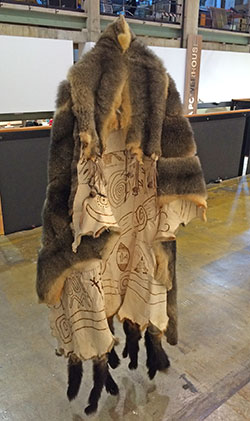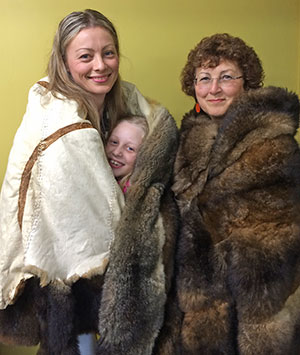 Every year, Bonnie’s along with other women’s services in this area, sponsors the Women’s Art Prize in the Mil-Pra Awards. These awards acknowledge the remarkable art work being done by Aboriginal people.
Every year, Bonnie’s along with other women’s services in this area, sponsors the Women’s Art Prize in the Mil-Pra Awards. These awards acknowledge the remarkable art work being done by Aboriginal people.
I was fortunate enough to be one of the judges this year and there were some amazing entries. The judges all had their favourites but it was a possum cloak that finally had us all in agreement. It was hand sewn from actual possum skins with possum tails hanging from the hem line. The inside of the cloak had a very detailed Aboriginal family story burnt into the skins. The whole dead animal thing was a bit much for me at first but when one of the judges, Rasheen explained what a Possum Cloak meant to her people, I suddenly understood. Only Healers wore the cloak. It was the respect and reverence in Rasheen’s voice, as she told the story, that gave the art piece meaning for me… and had me voting for the Possum Cloak too! I understood it. I felt her connection to it and it gave me a connection.
Afterwards, I just had to know more from the artist so Joy Brooke explained that she and her mother are Boandik people, and had made the cloak together.
I wanted to share Joy’s story with you:
Good day. We are proud Boandik women and our country is in Mount Gambier, South Australia. We are glad you are listening to our story about the Boandik country possum skin cloak. Traditionally, Boandik people wore possum skin cloaks. Babies were wrapped in the cloaks, and they were a prize possession of the Boandik people, accompanying the owner until death. Not only did they provide warmth, but a connection to country, family and culture. As proud Boandik women, with a strong sense of belonging and cultural identity, we have used a traditional practice, making a possum skin cloak, to retell our connections to country and family story.
 Annie Brice, our relative, was born about 1849 in an Aboriginal camp just near Old Penola Station. Her mother, a Boandik woman from Berrin was traded during a murapina of local Aboriginal tribes, to a man from the Pinejunga tribe, who lived around Penola and the Bool Lagoon area. As was customary with the Boandik tribe, males took more than one wife, so Annie had a half sister Lucy and half brother Tommy. Annie’s father was an Englishman who worked on the property for Alexander Cameron at Old Penola Station. Annie spent her childhood alternating between the black camp and the station. She spoke her traditional Aboriginal language, Bunganditj, as well as English, and because of the influence of Mary Mackillop, Cameron’s niece, Annie also learnt to write. Annie is mentioned many times in letters from Mary MacKillop to Father Woods. It mentions her eagerness to learn, read and write.
Annie Brice, our relative, was born about 1849 in an Aboriginal camp just near Old Penola Station. Her mother, a Boandik woman from Berrin was traded during a murapina of local Aboriginal tribes, to a man from the Pinejunga tribe, who lived around Penola and the Bool Lagoon area. As was customary with the Boandik tribe, males took more than one wife, so Annie had a half sister Lucy and half brother Tommy. Annie’s father was an Englishman who worked on the property for Alexander Cameron at Old Penola Station. Annie spent her childhood alternating between the black camp and the station. She spoke her traditional Aboriginal language, Bunganditj, as well as English, and because of the influence of Mary Mackillop, Cameron’s niece, Annie also learnt to write. Annie is mentioned many times in letters from Mary MacKillop to Father Woods. It mentions her eagerness to learn, read and write.
Yarning is a powerful medium for Aboriginal people to connect to one another, as well as share their connections to country. We appreciate the support and interest we have received from Bonnie Support Services, as recipients of the Liverpool Women’s Services Award this year, to continue to share our Aboriginal culture with family and community.
Wuwu
Brooke ba Michelle
Possum cloaks…different meanings for different people, with the real value placed on connection to country and family.
Written by Karen
comment closed